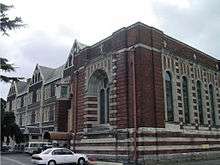Music Centre of Christchurch
The Music Centre of Christchurch was a facility for music organisations in the central city of Christchurch, New Zealand. It was established in 1994 and provides office, rehearsal, tuition and performance space for a wide range of music groups. The centre is adjacent to the Cathedral of the Blessed Sacrament and now consists of a group of four heritage buildings formerly the convent of the Sisters of Our Lady of the Missions and Sacred Heart College, a Catholic secondary school for girls founded in 1881 which was amalgamated with Xavier College, a neighbouring Catholic boys' school to form Catholic Cathedral College in 1987.

The chapel, built in 1907, by Joseph Munnings, Samuel Hurst Seager and Cecil Wood, is the primary performance space. It is one of the only examples of Byzantine revival architecture in the Southern Hemisphere. The three-storey main convent building, designed in 1882 by Francis Petre is the oldest building in the complex. It was opened in 1894. The Portery was added in 1902 to extend the convent. It was restored with the girls’ boarding hostel for Sacred Heart College, constructed in 1930. Both buildings became part of the music centre in 2004
The buildings were badly damaged in the 22 February 2011 Christchurch earthquake. Two of the centre's four buildings sustained significant earthquake damage. The three-storey main building has been demolished. It is hoped that the music centre will reopen on the existing site.
The Christchurch School of Music, one of the tenants of the Music Centre, had about 800 students attending weekly classes taught by 80 teachers at the Music Centre and the adjacent Catholic Cathedral College. Those classes were now being held at Christchurch Boys' High School and Rangi Ruru Girls' School.[1]
Notes
- Part of Chch music centre to be razed 12 April 2011, TVNZ website. (retrieved 25 January 2012)
Sources
| Wikimedia Commons has media related to Music Centre of Christchurch. |